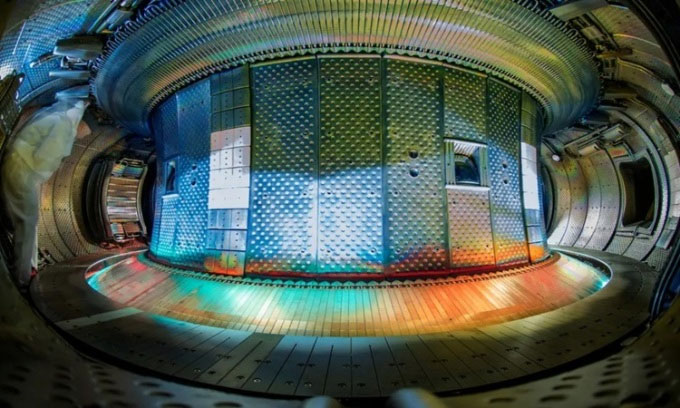French artificial sun sets plasma record
A reactor in southern France creates and maintains hot plasma of 50 million degrees Celsius for 6 minutes continuously, reaching an important milestone that helps make fusion energy a reality.
Scientists at the Princeton Plasma Physics Laboratory (PPPL), New Jersey, announced on May 6 that the device creates super-hot material called plasma at a temperature of 50 million degrees Celsius for 6 consecutive minutes, according to Business Insider . The ultimate goal is to maintain the super-hot plasma for many hours, but 6 minutes is still a new world record for a device like WEST. Other nuclear reactors similar to WEST produce hotter plasma that doesn't last as long.
WEST is a tokamak oven . This is a doughnut-shaped fusion reactor as large as a 2.4 x 2.4 meter room with a 2.4 meter high ceiling, producing the same type of energy as the Sun. That's why scientists call these machines "Artificial Suns". "What we're trying to do is create the Sun on Earth," said Luis Delgado-Aparicio, senior project manager at PPPL. "It's a huge challenge ," but the new record shows they're on the right track.

Inside the WEST reactor. (Photo: PPPL)
The sun operates through fusion reactions (where atomic nuclei combine and release energy), which is different from fission (where atomic nuclei split and create energy) in reactors. The nucleus is active today. Fusion energy is more powerful than any form of energy we have today. If humans could harness fusion, it could produce nearly 4 million times more energy per kilogram of fuel than fossil fuels and without emitting carbon.
While WEST is not being used to produce fusion electricity for households, this test reactor helps lay the foundation for future commercial reactors. WEST has much in common with ITER, the reactor under construction in southern France and the world's largest tokamak that can sustain its plasma combustion when completed. Creating such a self-heating mixture is a necessary step in harnessing the power of fusion for commercial purposes. However, due to cost and technology issues, it is unclear when ITER will be completed. Meanwhile, other facilities, including WEST, are conducting experiments to find the best way to operate the giant reactor. ITER and WEST are located quite close to each other and the experiments at WEST can be directly applied to ITER, according to Delgado-Aparicio.
For a fusion reaction to occur on Earth, the fuel needs to reach a temperature of at least 50 million degrees Celsius. One of the main obstacles that fusion reactors face is the enormous amount of energy needed to create the extremely high temperatures. term. To date, reactors have not been able to maintain plasma long enough to achieve a commercially usable energy surplus. Currently, fusion reactors often consume more energy than they produce. WEST's latest breakthrough is no exception. However, the facility produced 15% more energy from the fusion reaction than in previous tests, and the plasma was also twice as dense.
WEST is helping scientists test the best materials to build fusion reactor walls because this environment can reach temperatures more than three times hotter than the Sun's core. Initially, WEST included carbon walls. While carbon is easy to process, it also absorbs tritium, a rare hydrogen isotope used as fuel for fusion reactions.
So, in 2012, scientists decided to test another material for tokamak furnace walls, tungsten . That is also the material that the ITER furnace will use for some key parts. Because tungsten is able to withstand heat without absorbing tritium, Delgado-Aparicio said it was an ideal material for the walls of tokamak furnaces. However, tungsten is not perfect, one of its limitations is that it can melt and contaminate the plasma. To optimize the system, the team needed to understand exactly how tungsten behaves and interacts with plasma through WEST.
The team of experts at PPPL adapted a diagnostic tool for use in the latest experiment from WEST. This tool helps them accurately measure plasma temperature to better understand how tungsten transfers from the device wall to the plasma. PPPL said it will publish the results of the experiment in a professional journal in the coming weeks.
- Korea's 'artificial sun' sets a new record
- This is the artificial sun that has just been 'born' in America
- China successfully tested 'Artificial Sun'
- Z-machine generates hot plasma gas with a record temperature of more than 2 billion Kelvin
- Earth often leaks plasma out of space
- Chorus of plasma waves around the Earth
- LHC accelerator sets a new record
- How does cold plasma support healing open wounds?
- All of us are
- 19-year-old girl sets world record to fly around the world
- Hydrogen plane sets world record, can fly higher than 2,000 m
- New plasma technology can kill 99.9% of pathogens in the air
 Norway built the world's tallest wooden tower
Norway built the world's tallest wooden tower Kremlin
Kremlin Ashurbanipal: The oldest royal library in the world
Ashurbanipal: The oldest royal library in the world Decoding the thousand-year construction of Qin Shihuang shocked the world
Decoding the thousand-year construction of Qin Shihuang shocked the world